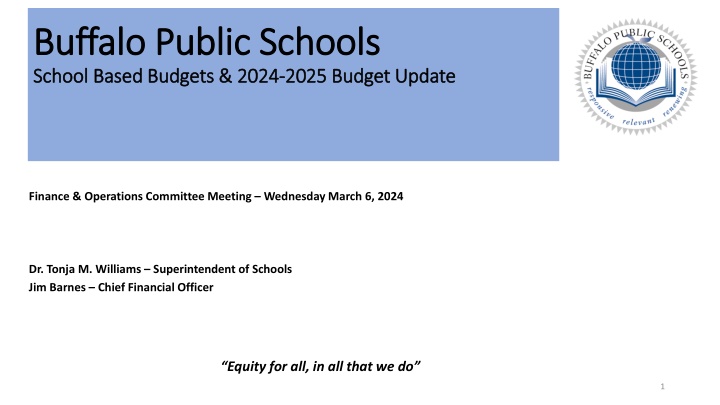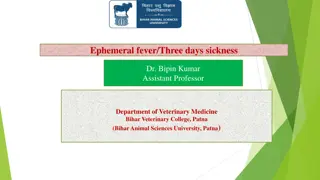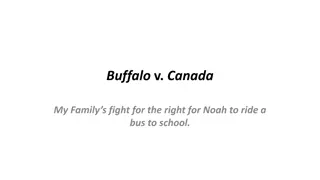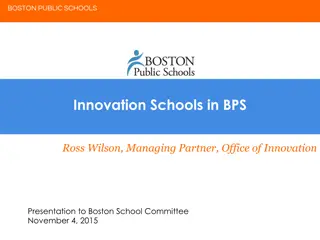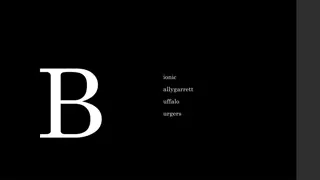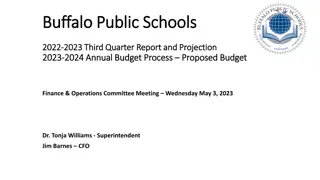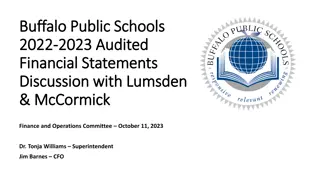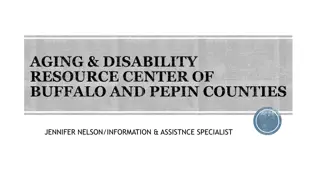Buffalo Public Schools
The Buffalo Public Schools district is addressing challenges in its 2024-2025 budget update, focusing on student proficiency goals, financial strategies, and resource allocation.
Download Presentation

Please find below an Image/Link to download the presentation.
The content on the website is provided AS IS for your information and personal use only. It may not be sold, licensed, or shared on other websites without obtaining consent from the author.If you encounter any issues during the download, it is possible that the publisher has removed the file from their server.
You are allowed to download the files provided on this website for personal or commercial use, subject to the condition that they are used lawfully. All files are the property of their respective owners.
The content on the website is provided AS IS for your information and personal use only. It may not be sold, licensed, or shared on other websites without obtaining consent from the author.
E N D
Presentation Transcript
Buffalo Public Schools Buffalo Public Schools School Based Budgets & 2024 School Based Budgets & 2024- -2025 Budget Update 2025 Budget Update Finance & Operations Committee Meeting Wednesday March 6, 2024 Dr. Tonja M. Williams Superintendent of Schools Jim Barnes Chief Financial Officer Equity for all, in all that we do 1
3 Goals for the Superintendent 3 Goals for the Superintendent The Board has identified 3 Goals for the Superintendent by 6/2024. To support the achievement of the following Goals: 1. The percentage of BPS third grade economically disadvantaged students proficient in Reading as measured by the end of year (EOY) Dibels Assessment will increase from 33% in June 2023 to 39% by June 2024. 2. The percentage of BPS third grade economically disadvantaged students proficient in Math as measured by the EOY iReady Assessment will increase from 13.3% in June 2023 to 15.9% by June 2024. 3. The percentage of Unofficial 4-year graduation cohort students who complete state and district graduation requirements will remain consistent from 75.7% in June 2021 to 75.7% in June 2024. It will be necessary for the district to strategically prioritize all financial systems, practices, and human capital. 2
Objectives for Tonight Objectives for Tonight Share the Big Picture with right sizing district resources. Reiterate the data related to post ARP/ESSER budgeting and the 4 Year Plan. Explicit review of the Level 1 Budget (detail, revenues, expenditures). Identify the current status of the Level 2 Budget Process. The School Based Budget background information. Begin discussing the Updated 4 Year Plan due June 30, 2024. Summation. 3
The Big Picture The Big Picture The two biggest challenges facing the district are the loss of $90 million in ARP/ESSER revenues AND aligning total staff counts to enrollment decreases as in all districts across the state and country. Enrollments are down 3,400 over past 5 years. The 24-25 budget process will address the District s structural challenges and the strong implementation of the 4 Year Plan. Level 1 Budget shows a $101 million deficit and an increase of 350 budgeted staff. It is a starting point, worst case scenario and unsustainable. Level 2 of the Budget Process is underway. Department budgets are due back March 15, 2024. We are requesting flat non staff expenditures. The SBB books are due March 11, 2024. Across the district 34 classrooms are being consolidated due to lower than expected enrollments. This will result in an average class size of 21 throughout the district. We are not accepting unbudgeted requests at this point in the budget process. Plan to mitigate/avoid layoffs: Hiring freeze (except for essential positions). Cutting non-mandated vacancies at both central office and schools, as best we can. No unbudgeted requests during the SBB process. Use of projected retirements. The Superintendent is keenly aware of the needs of our students schools and departments and is more committed than anyone to provide the resources to meet those needs in the 24-25 budget.4
Level 1 Budget Detail Level 1 Budget Detail 24-25 L1 PRELIM 1,079,409,600 23-24 BUDGET 1,065,000,000 VARIANCE 14,409,600 % 1.35% GOV BUDGET PROPOSAL. NOTES REVENUES (NO USE OF RESERVES) INCLUDES CURRENT STAFF + DC24 WITH STEP, LONG AND CONTRACT INCREASES. INCLUDES 29 MILLION ON DC24 NON STAFF. BENEFITS AND CHARTER INCREASES. DOES NOT INCLUDE VACANCY CUTS. SEE DETAILED ANALYSIS. EXPENDITURES (NOT RECONCILED) 1,180,566,596 1,102,725,000 77,841,596 7.06% SURPLUS (DEFICIT) (101,156,996) (37,725,000) (63,431,996) 4 YEAR PLAN SURPLUS (DEFICIT) (29,400,000) (37,725,000) PER 4 YEAR PLAN FTES - GENERAL FUND (NOT RECOENCILED) ADD - ARP ESSER 5,010 313 4,965 - TOTAL 5,323 4,965 358 7.21% BEGINNING GEN FUND - FUND BALANCE TOTAL (AUDITED) L1 DEFICIT PROJECTED END FUND BALANCE The L1 Budget shows a 1.4% increase in revenues and a 7% increase in expenditures. 375,527,368 (101,156,996) 274,370,372 The L1 Budget shows a $101 million deficit. This is $72 million greater than the deficit projected in the current 4 Year Plan. The Current 4 Year Plan calls for a deficit of $29 million. The L1 Budget includes all ARP funded positions and all current vacancies. 5
Level 1 Budget Detail Level 1 Budget Detail - - Revenues Revenues Revenue Category Sum of 23-24 CY REVISED (1,065,000,000) Sum of 24-25 LEVEL 1 (70,718,966) (56,000,000) (937,436,206) (1,079,409,600) Sum of L1 - CY 23-24 (18,597,742) (14,409,600) % Change City Interfund Medicaid Other Sales Tax State Aid Tuitions to Other Districts (70,718,966) (11,500,000) (3,000,000) (4,847,051) (53,200,000) (918,838,464) (2,895,519) - 0 (3,500,000) (3,000,000) (5,158,909) 8,000,000 -69.57% 0.00% 6.43% 5.26% 2.02% 24.18% - (311,858) (2,800,000) (3,595,519) (700,000) - - - Grand Total 1.35% Revenue numbers appear as negatives (credits) in the Munis system. L1 Revenues are up $14 million or 1.4%. State Aid revenues are up $19 million or 2%. During L2 we may receive the final State Budget revenue numbers. 6
Level 1 Budget Detail Level 1 Budget Detail - - Expenditures Expenditures Level 1 24-25 VS CY 23-24 Revised Budget - General Fund Sum of 2023-24 REVISED BUDGET FTE 4,965 - - - - - - - - - - - Sum of 2024-25 LEVEL 1 FTE -CY REV FTE Sum of 2024-25 LEVEL 1 BUDGET -CY REV BUDGET 35,481,430 10,876,428 16,093,900 (1,576,299) Sum of 2023-24 REVISED BUDGET 401,604,772 212,567,366 38,564,308 158,918,700 62,920,424 100,961,299 3,715,514 43,250,404 20,582,787 34,908,757 12,433,150 12,297,520 Sum of 2024-25 LEVEL 1 FTE 5,323 437,086,203 - 221,567,366 - 49,440,735 - 175,012,600 - 66,935,358 - 100,961,299 - 5,915,514 - 43,218,263 - 19,006,488 - 34,908,757 - 12,633,150 - 13,880,863 Sum of 2024-25 LEVEL 1 BUDGET Expenditure Category 1-Salaries 2-Benefits 3-Contracts 4-Charter School Tuition 5-Transportation 6-Debt Service 7-Interfund Transfer 8-Equpment, Rentals, Repairs, Custodian 9-Supplies, Textbooks, Software 10-Tuition and Contingency 11-Utilities 12-Contingency 358 - - - - - - - - - - - 9,000,000 4,014,934 - 2,200,000 (32,140) - 200,000 1,583,343 Grand Total 4,965 1,102,725,000 5,323 1,180,566,596 358 77,841,596 L1 Expenditures are up $78 million or 7% from the Current Year General Fund expenditures. The L1 budgeted FTE count contains approximately 300 ARP funded positions and 275 vacancies. We also have vacancies in Grant Funds and the Retirees to utilize. The objective of L2 is to reduce the budgeted FTE count by approximately 300 and the total expenditures by approximately $30 million. 7
Level 2 Budget Level 2 Budget - - Current Status and Time Current Status and Time- -Line for Completion Line for Completion Department Budgets: The due date for Level 2 budget entry is March 15th. We are asking all departments to enter flat overall non staff budgets. SBB Process: Based upon the decrease in enrollments, PK-8 classrooms were reduced by 34 (including 5 bilingual). After this classroom reduction the district average PreK-8 class size is approximately 21. No school has an average classroom size of over 25. The books are due back from the schools to OSL on March 11th. The SBB approval meetings are scheduled for the period March 19th March 27th. At the end of this process we will identify and cut school based vacancies. Central Office Reductions: We are meeting with each cabinet member and have reduced 21 positions and approximately $2 million dollars from the Level 1 budget to date. Our goal is to reduce Central Office positions proportionately equal to School Based reductions. Additional meetings are scheduled for this week and next. Audit related expenditure cuts ($1.5 million) and revenue increases ($1 million). The Final Legislative Budget with Final State Aid Revenues is due around March 31, 2024. The Level 2 Budget projection will be presented in early April. 8
The SBB Process The SBB Process Background Information Background Information The resources provided to each school are based upon enrollments and needs. High needs include ELL counts, FRPL counts, SPED counts and Academic results. Seat projections are created for each school based on actual enrollment data. Then baseline staff (elementary teachers, encore are teachers, subject area teachers, guidance, administration, clerical, aides) is allocated through district adopted formulas based on that enrollment. District adopted formulas last changed in 2022-23 when the allocations for assistant principals, guidance counselors and aides/assistants were increased. We are not changing these increases. Several departments allocate resources based on needs rather than straight enrollment (special ed, multilingual, attendance). This will not change. Additional funding is allocated through various sources (CFE, MAG, Title I, CSP) based on academic performance, demographics, student need. Schools did not receive ARP funds in their 24-25 budgets, as this funding source has expired. Other funding sources have remained the same or increased. Schools make decisions within their budget to allocate those resources to meet needs specific to their school. 9
Updated 4 Year Plan Due June 30, 2024 Updated 4 Year Plan Due June 30, 2024 We manage our finances in the short term with detailed reviews of current year spending versus the Approved Budget, monthly monitoring of critical variables, Quarterly Reports to the Board and cash flow management. More importantly we manage our district finances according to a 4 Year Plan that incorporates the projected consequences of the decisions we make every budget year on our Fund Balances. Our financial analysis of the new BTF contract included reducing total budgeted BTF staff count by 160 vacancies due to declining enrollments. The current 4 Year Plan also includes a reduction of 160 vacant BTF positions or the elimination of all ARP/ESSER funded BTF positions. Our current Approved 4 Year Plan (June 9, 2023) includes the following note & data on page six of the document. 1)Gap Closing Measures - Gap closing measures, which will likely become necessary at some point during this Plan will need to focus on the structure of our schools, both in terms of numbers of schools, the number of students at those schools, and how they are funded. Ultimately, as these Plans have stated for many years, there has been a flat number of students in Buffalo (District and charter combined), and as more charter schools open, and existing charter schools continue to grow, the spending on District schools must eventually shrink to match the reduced student population in District schools. In the last decade, we have not systemically reduced the physical footprint or staffing of our schools to match the student population loss unprecedented State and Federal aid has masked the structural imbalance. The District should prepare a study to assist in aligning staffing and facilities over the long-term to student counts. Below is a table pulled from the 2023-2024 Budget Book showing the decreasing enrollments and increased school-based staff over the past few years. These trends are more pronounced the further back the data: Projected 23-24 Rev 20-21 Rev 21-22 Rev 22-23 BEDS PK-12 30,952 30,471 29,778 29,478 School Based Budget Enrollment 33,510 32,783 32,025 31,065 School Based Staff FTE 4,650 4,719 4,891 4,889 Annual Staff Change 69 172 (2) 10 Cumulative SBB Staff Change 69 241 239
Summary Remarks Summary Remarks All of us must approach the 24-25 Budget Process with a new mind set incorporating the economic realities of the ARP/ESSER financial cliff and lower enrollments impacting all school districts. Our budget decisions must be data driven. We are in a better position to deal with these challenges than most districts. Our plan revolves around flat non staff budgets AND a hiring freeze, cutting vacancies, NO unbudgeted requests during the SBB process and utilizing retirements to avoid layoffs. The 4 Year Plan is the key financial planning tool for the District. It incorporates future year projections for the decisions made during the current year budget process and the impact on our fund balance. From a financial planning and cash flow perspective there will no longer be substantial vacancy savings to rely upon for budgetary savings. We have to manage better with the resources provided within the budget. There is no room for unbudgeted requests in the coming year. 11
Buffalo Board of Education Buffalo Board of Education Dr. Tonja M. Williams, Superintendent of Schools Hon. Sharon M. Belton-Cottman, President and Ferry District Board Member Hon. Dr. Kathy Evans - Brown, Vice-President of Executive Affairs and East District Board Member Hon. Lawrence L. Scott, Vice-President of Student Achievement and Board Member-at-Large Hon. Terrance L. Heard, Board Member-at-Large Hon. Cindi M. McEachon, North District Board Member Hon. Jennifer L. Mecozzi, West District Board Member Hon. Dr. Ann R. Rivera, Board Member-at-Large Hon. Theresa Schuta, Park District Board Member Hon. Paulette Woods, Central District Board Member Ms. Daijha Mims, Student Representative 12
